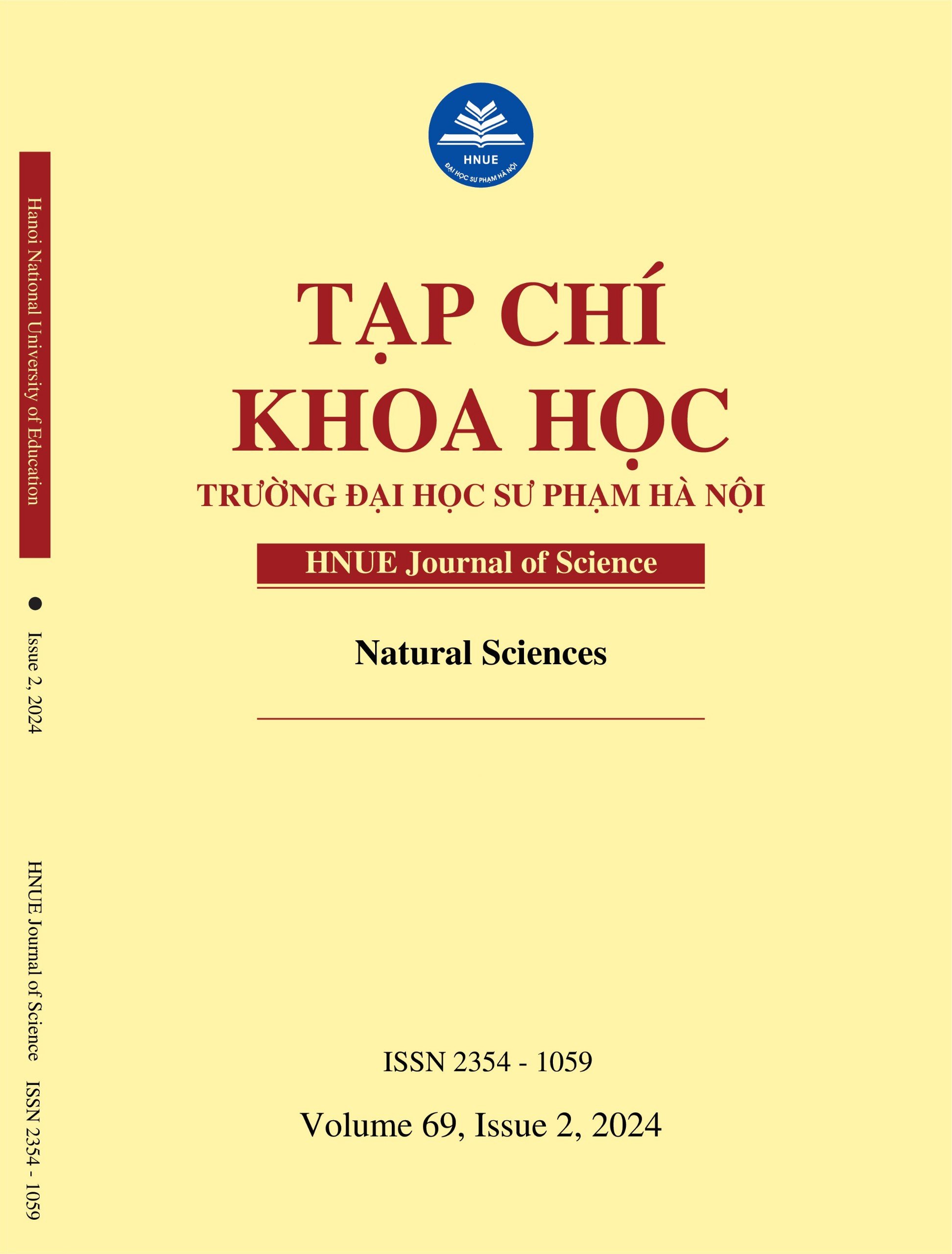NEW RECORDS OF ECHOLOCATION CALLS OF Hipposideros khaokhouayensis
DOI:
https://doi.org/10.18173/2354-1059.2024-0027Keywords:
bat, echolocation, Hipposideridae, Laos, VietnamAbstract
Phou Khao Khouay leaf-nosed bat (Hipposideros khaokhouayensis) is a globally rare and vulnerable species of the family Hipposideridae. It has been known only from the type locality in Laos and two localities in Vietnam. Its echolocation calls were included in several publications but still poorly understood. Between November 2023 and April 2024, the authors conducted three field surveys in Lang Son province and Hai Phong city, northeastern Vietnam, in order to seek further understanding of its potential distribution and echolocation behavior. Twelve adult individuals of the species were captured using harp traps and mist nets for identification in the field based on their morphological diagnoses to confirm the target species' identity. The PCTape system was employed to record echolocation calls while bats were emerging from caves. Seven sound parameters (CF frequency, CF duration, tFM frequency, tFM bandwidth, tFM duration, pulse duration, and inter-pulse interval) of the recorded calls were analyzed and measured using the Selena software. Their values are in a range of 90.2 - 91.1 kHz, 3.1 - 8.9 ms, 75.6 - 84.5 kHz, 6.1 - 15.0 kHz, 0.9 - 1.7 ms, 4.5 - 10.1 ms and 15.1 - 31.4 ms, respectively. The present study results are considerably different from descriptions in previous publications. This paper also provides the first data on the inter-pulse interval of the species echolocation calls and a methodological note on this sound parameter.
References
[1] Douangboubpha B, (2020). Hipposideros khaokhouayensis (amended version of 2019 assessment). The IUCN Red List of Threatened Species 2020: e.T136819A166602959. https://dx.doi.org/10.2305/IUCN.UK.2020-1.RLTS.T136819A166602959.en. Accessed on 04 June 2024.
[2] Guillen-Servent A & Francis CM, (2006). A new species of bat of the Hipposideros bicolor group (Chiroptera: Hipposideridae) from Central Laos, with evidence of convergent evolution with Sundaic taxa. Acta Chiropterologica, 8(1), 39-61.
[3] Tuneu-Corral C, (2019). Phou Khao Khouay leaf-nosed bat (Hipposideros khaokhouayensis). In: Wilson DE, Mittermeier RA, (1st ed.), Handbook of the mammals of the world - Volume 9: Bats. Lynx Edicions, Barcelona, p. 255.
[4] Vu DT, (2021). Taxonomy and echolocation of Vietnamese bats, (1st ed.). Publishing House for Science and Technology, Hanoi, Vietnam, p. 258.
[5] Vu DT, Dietz C, Schinitzler H-U, Denzinger A, Furey NM, Borisenko AV & Bates PJJ, (2008). First record of Hipposideros khaokhouayensis (Chiroptera: Hipposideridae) from Vietnam. HNUE Journal of Science, 53(5), 138-143.
[6] Vu DT & Furey NM, (2008). The bat fauna of Cat Ba Biosphere Reserve. Academia Journal of Biology (formerly Journal of Biology), 30(3), 73-77 (in Vietnamese).
[7] Abramov AV & Kruskop SV, (2012). The mammal fauna of Cat Ba Island, Northern Vietnam. Russian Journal of Theriology, 11(1), 57-72.
[8] Kruskop SV, (2013). Bats of Vietnam: Checklist and an identification manual (2nd ed.). Moscow, Russia, p. 299.
[9] Vu DT, Do TD & Nguyen VT, (2016). An overview of bat research in Cat Ba biosphere reserve with remarks on previous records. Proceedings of the 2nd national scientific conference on biological research and teaching in Vietnam. Publishing House of the Vietnam National University, 737-744.
[10] Vu DT, Sichanh S & Nha PV, (2020). The conservation status of bats (Mammalia: Chiroptera) in Cat Ba National Park, northeastern Vietnam. HNUE Journal of Science, 65(10), 92-98.
[11] Vu DT, Denzinger A, Nguyen VS, Nguyen TTH, Hoang TT, Dao NL, Pham VN, Nguyen VV, Pham DT, Tuanmu M-N, Huang JC-C, Ladthavong T, Nguyen TL. & Schnitzler H-U, (2021). Bat Diversity in Cat Ba Biosphere Reserve, Northeastern Vietnam: A Review with New Records from Mangrove Ecosystem. Diversity, 13(376), 1-29.
[12] Vu DT, (2023). New Data on Distribution, Morphology and Echolocation of Hipposideros khaokhouayensis Guillén-Servent & Francis, 2006 (Chiroptera: Hipposideridae). Acta Zoologica Bulgarica, 75(4), 469-476.
[13] Francis CM, (1989). A comparison of mist nets and two designs of harp traps for capturing bats. Journal of Mammalogy, 70(4), 865-870.
[14] Sikes RS & Animal Care and Use Committee of the American Society of Mammalogists, (2016). Guidelines of the American Society of Mammalogists for the use of wild mammals in research and education. Journal of Mammalogy, 97(3), 663-688.
[15] Sikes RS & Gannon WL, (2011). Guidelines of the American Society of Mammalogists for the use of wild mammals in research. Journal of Mammalogy, 92(1), 235-253.
[16] Racey PA, (2009). Reproductive assessment of bats. In: Kunz TH, Parsons S (eds.), Ecological and Behavioural Methods for the Study of Bats, (2nd ed.), p. 249-264. The John Hopkins University Press.
[17] Brunet-Rossinni AK & Wilkinson GS, (2009). Methods for age estimation and the study of senescence in bats. In: Kunz TH, Parsons S (eds.), Ecological and Behavioural Methods for the Study of Bats, (2nd ed.), p. 315-325. The John Hopkins University Press.
[18] Vu DT, (2023). Remarks on the diversity and echolocation calls of hipposiderid bats (Chiroptera: Hipposideridae) in Cuc Phuong National Park, northeastern Vietnam. Academia Journal of Biology, 45(4), 1-9.
[19] Tian B & Schnitzler H-U, (1997). Echolocation signals of the greater horseshoe bat (Rhinolophus ferrumequinum) in transfer flight and during landing. The Journal of the Acoustical Society of America, 101(4), 2347-2364.
[20] Neuweiler G, Metzner W, Heilmann U, Riibsamen R, Eckrich M & Costa HH, (1987). Foraging behaviour and echolocation in the rufous horseshoe bat (Rhinolophus rouxi) of Sri Lanka. Behavioral Ecology and Sociobiology, 20, 53-67.
[21] Schnitzler H-U & Denzinger A, (2011). Auditory fovea and Doppler shift compensation: adaptations for flutter detection in echolocating bats using CF-FM signals. Journal of Comparative Physiology A, 197, 541-559.
[22] Starik N & Göttert T, (2022). Bats adjust echolocation and social call design as a response to urban environments. Frontiers in Ecology and Evolution, 10: 939408. doi: 10.3389/fevo.2022.939408.







